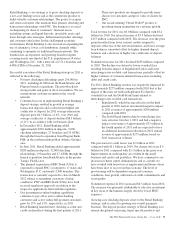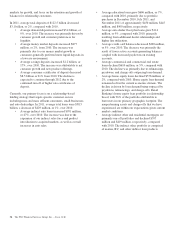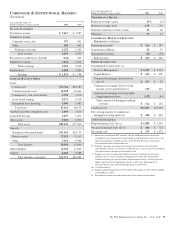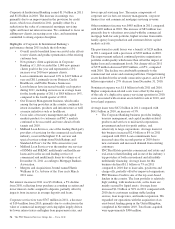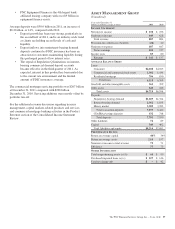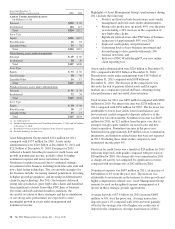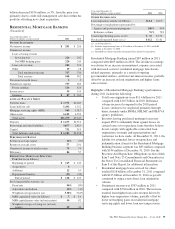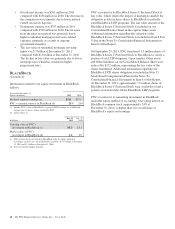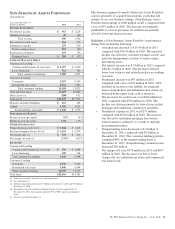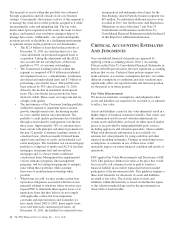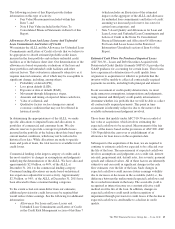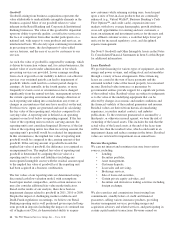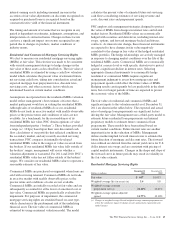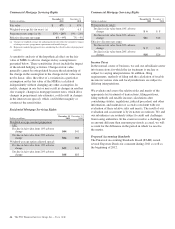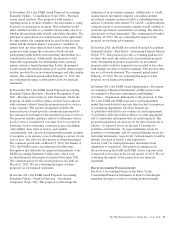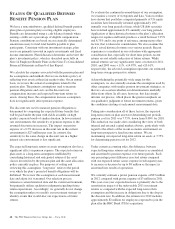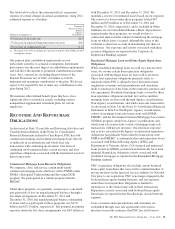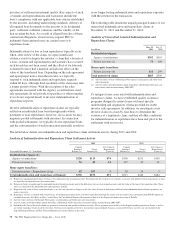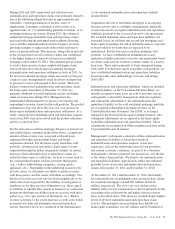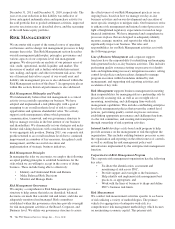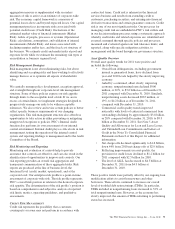PNC Bank 2011 Annual Report Download - page 72
Download and view the complete annual report
Please find page 72 of the 2011 PNC Bank annual report below. You can navigate through the pages in the report by either clicking on the pages listed below, or by using the keyword search tool below to find specific information within the annual report.The following sections of this Report provide further
information on this type of activity:
• Fair Value Measurements included within this
Item 7, and
• Note 8 Fair Value included in the Notes To
Consolidated Financial Statements in Item 8 of this
Report.
Allowances For Loan And Lease Losses And Unfunded
Loan Commitments And Letters Of Credit
We maintain the ALLL and the Allowance for Unfunded Loan
Commitments and Letters of Credit at levels that we believe to
be appropriate to absorb estimated probable credit losses
incurred in the loan portfolio and on these unfunded credit
facilities as of the balance sheet date. Our determination of the
allowances is based on periodic evaluations of the loan and
lease portfolios and unfunded credit facilities and other
relevant factors. This evaluation is inherently subjective as it
requires material estimates, all of which may be susceptible to
significant change, including, among others:
• Probability of default (PD),
• Loss given default (LGD),
• Exposure at date of default (EAD),
• Movement through delinquency stages,
• Amounts and timing of expected future cash flows,
• Value of collateral, and
• Qualitative factors such as changes in current
economic conditions that may not be reflected in
historical results.
In determining the appropriateness of the ALLL, we make
specific allocations to impaired loans and allocations to
portfolios of commercial and consumer loans. We also
allocate reserves to provide coverage for probable losses
incurred in the portfolio at the balance sheet date based upon
current market conditions, which may not be reflected in
historical loss data. While allocations are made to specific
loans and pools of loans, the total reserve is available for all
credit losses.
Commercial lending is the largest category of credits and is
the most sensitive to changes in assumptions and judgments
underlying the determination of the ALLL. We have allocated
approximately $2.0 billion, or 46%, of the ALLL at
December 31, 2011 to the commercial lending category.
Consumer lending allocations are made based on historical
loss experience adjusted for recent activity. Approximately
$2.3 billion, or 54%, of the ALLL at December 31, 2011 have
been allocated to these consumer lending categories.
To the extent actual outcomes differ from our estimates,
additional provision for credit losses may be required that
would reduce future earnings. See the following for additional
information:
• Allowances For Loan and Lease Losses and
Unfunded Loan Commitments and Letters of Credit
in the Credit Risk Management section of this Item 7
(which includes an illustration of the estimated
impact on the aggregate of the ALLL and allowance
for unfunded loan commitments and letters of credit
assuming we increased pool reserve loss rates for
certain loan categories), and
• Note 5 Asset Quality and Allowances for Loan and
Lease Losses and Unfunded Loan Commitments and
Letters of Credit in the Notes To Consolidated
Financial Statements and Allocation Of Allowance
For Loan And Lease Losses in the Statistical
Information (Unaudited) section of Item 8 of this
Report.
Estimated Cash Flows On Purchased Impaired Loans
ASC 310-30 – Loans and Debt Securities Acquired with
Deteriorated Credit Quality (formerly SOP 03-3) provides the
GAAP guidance for accounting for certain loans. These loans
have experienced a deterioration of credit quality from
origination to acquisition for which it is probable that the
investor will be unable to collect all contractually required
payments receivable, including both principal and interest.
In our assessment of credit quality deterioration, we must
make numerous assumptions, interpretations and judgments,
using internal and third-party credit quality information to
determine whether it is probable that we will be able to collect
all contractually required payments. This point in time
assessment is inherently subjective due to the nature of the
available information and judgment involved.
Those loans that qualify under ASC 310-30 are recorded at
fair value at acquisition, which involves estimating the
expected cash flows to be received. Measurement of the fair
value of the loan is based on the provisions of ASC 820. ASC
310-30 prohibits the carryover or establishment of an
allowance for loan losses on the acquisition date.
Subsequent to the acquisition of the loan, we are required to
continue to estimate cash flows expected to be collected over
the life of the loan. The measurement of expected cash flows
involves assumptions and judgments as to credit risk, interest
rate risk, prepayment risk, default rates, loss severity, payment
speeds and collateral values. All of these factors are inherently
subjective and can result in significant changes in the cash
flow estimates over the life of the loan. Such changes in
expected cash flows could increase future earnings volatility
due to increases or decreases in the accretable yield (i.e., the
difference between the undiscounted expected cash flows and
the recorded investment in the loan). The accretable yield is
recognized as interest income on a constant effective yield
method over the life of the loan. In addition, changes in
expected cash flows could result in the recognition of
impairment through provision for credit losses if the decline in
expected cash flows is attributable to a decline in credit
quality.
The PNC Financial Services Group, Inc. – Form 10-K 63


